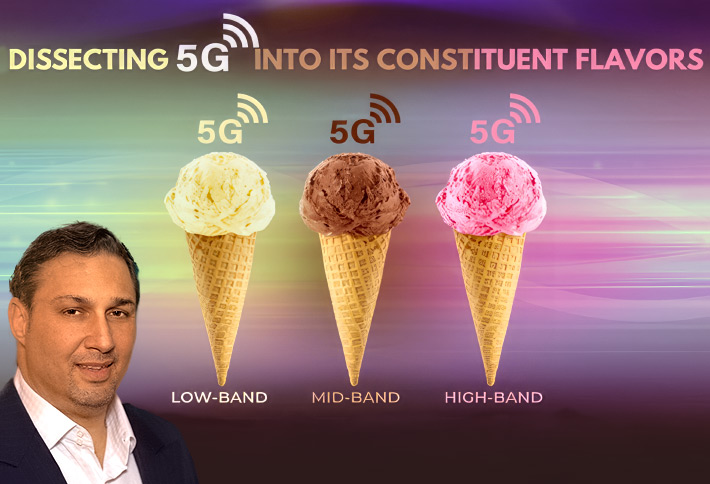
5Gelato? Subcarrier Communications President John Paleski uses Neapolitan ice cream flavors to easily explain low, mid, and high-band frequencies utilized for 5G.
By John Paleski
Mobile broadband businesses were eager to shell out over $120 billion during FCC auctions to acquire spectrum blocks to roll out 5G. That’s understandable since they needed it to lay the groundwork for fifth-generation wireless services.
However, understanding what 5G is and the spectrums used to offer transformational speeds and capabilities that can open the door to a whole new world of game-changing possibilities can be confusing.
It might be easier to discuss it in more relatable terms by comparing it to the layers of Neapolitan ice cream with vanilla, chocolate, and strawberry layers. Bon appétit!
First, let’s look at the broad strokes of 5G. At its peak, 5G download speeds are up to 100 times faster than 4G. In addition, 5G has now taken shape and supports “smart factories” and the industrialized IOT (Internet of Things).
The promise of 5G from 2019 included the dream of ultra-high data rates with low latency. Latency can be understood as how long data travels from one designated point to another or from one wireless device to another.
Low latency means less time and increased efficiency; high latency means more time. With 5G, lower latency will be a ten-fold improvement over 4G; moving your data from point A to point B is much faster. In addition, many remote functions will be processed in real time. Latency, coverage, and capacity are all key metrics here.
It’s low latency which will be the key to driverless cars, real-time financial transactions, telemedicine/surgery, and beyond. Latency here is described in milliseconds. 5G has 1 ms of latency, which is a rate imperceptible to humans, but these innovations will lend to further advancements in technology unthinkable today. All connected devices will instantly transmit to the internet and exchange data in real time. Think about how this will improve our overall lives. Manufacturing and production plants are becoming more autonomous and efficient, as well as schools, planning and design entities, law firms and the medical community, market trades, banking, and mobile technology.
We can break down and look at 5G in three layers or three flavor frequency blocks. Like the tasty colored layers of Neapolitan ice cream, each layer (low-band, mid-band, and high-band) of 5G has its characteristics, and intended applications, from speed reach to geographic coverage area, so what’s your flavor? Vanilla (low-band), chocolate (mid-band), or Strawberry (high-band)?
“Vanilla,” here, includes the 800 Mhz frequency block, which is the old cellular telephone band. This band is used primarily for voice and texting applications. The purpose is to establish a general background of 5G coverage to a wide area. It’s sometimes called the “backbone service” since it’s primarily used for broad nationwide coverage. The frequencies used here are between 600 and 800MHz and deliver data rates from 30 to 75 Mbps. Old analog cellular wasn’t even digital, so our signals no longer fade in and out. With digital, you either have signal or you do not.
“Chocolate,” here, represents “mid-band” 5G. The original PCS and 3G band was to revolutionize everything, but when 3G arrived, a very excited Verizon, AT&T, and T-Mobile did so much hype and marketing before Christmas that it gained many subscribers, so many that it slowed the system down again. But it allowed more data and texting; we could upload and download pictures versus today, where we are downloading and uploading entire movies. This layer is considered the sweet layer of the 5G spectrum. It is faster than low-band with better reach than the high-band or millimeter wave spectrum. Although it’s best for extensive urban and suburban areas, it is also used for LTE. The new 5G paradigm is coverage, capacity, and latency, all working harmoniously. The frequency blocks at play here are between 2.5GHz and 6GHz. Mid-band 5G provides high capacity, coverage over large service areas, and lower latency speeds. It delivers data rates from 175 to 225 Mbps. This band also seeks to harmonize international calling applications.
“Strawberry,” here, represents the “high-band” 5G, or 5G millimeter wave. This band includes all the new frequencies that the FCC recently auctioned off. This makes the layers much wider to appeal to massive amounts of data. A direct result of all the FCC auctions that added all the FCC bands. 5G service, in some cases, is going to 5G+ as they add to the blocks and streamline frequencies. 5G is intended to provide ultra-high-speed connectivity in dense metropolitan areas at 10 to 15 Gbps. Its frequency range is between 24 GHz and 40 GHz. This solution can meet increasing high-speed traffic demands and expand broadband services. It’s best suited for inside manufacturing facilities, office buildings, and other dense settings. Although the millimeter spectrum is blazing fast, it does not carry far – about 1,000 feet, making it ideal for dense city areas.
When examining the flavors of 5G, we must look at the same ideas as we did with 3G – namely coverage and capacity; however, with 5G, we’ve added the critical component of low latency. Does the wireless network reach my location, and is the latency low enough to run my applications? Does it have the capacity to meet my needs? Each wireless system provider, Verizon, AT&T, T-Mobile, and now Dish Networks, has their trade-offs, but with each “flavor” of 5G available, it can solve differing consumer needs. So now you get all the flavors you want- in one scoop with better coverage, capacity, and latency.
A lot depends on synchronizing all frequencies into a more efficient upload and download process. Intel and Samsung have some influence to a certain degree, but Qualcomm appears to be the leader and owns the market. Newer refinements continue to take place. Qualcomm’s new processing chips boast higher data rates, and the degree to which they integrate all those layers of frequencies into the phones can and will continue to improve dramatically, depending upon the refinements by Qualcomm chip technologies and upgrades as well as other competitors.
With everything broken down thus far, some concerns about 5G are involved explicitly with various spectrum policy and auction design issues. According to Brattle.com, which recently conducted a study “concerning spectrum allocation and design,” the question is, is there enough spectrum from the FCC’s auction pipeline for wireless to make the leaps and bounds it promises its customers? For example, with the push for IoT, higher millimeter-wave frequencies are needed to deliver faster transmission.
According to media reports, the Brattle Group concluded that the United States is looking at “a major spectrum deficit” if Congress does not restore the FCC’s spectrum auction authority. Other studies requested by the CTIA and conducted by Boston Consulting Group revealed potential congestion issues due to spectrum shortages for 5G. As 5G continues to evolve, it will be more of a marathon, not a sprint, as technology and carriers adapt to what is available according to the spectrum the FCC makes available at government pace, which, unfortunately, is a slow process. The positive side is that the industry will have plenty of time to tweak and improve as more spectrum can be auctioned off.
Fortunately, we have enough frequency blocks to do the job; we need the chips to improve and do the job better, which are forthcoming. So if you think 5G is fast (and it certainly is), then wait for 6G to make its debut once we have enough spectrum!
There have recently been efforts by the engineering community to further develop millimeter and terahertz waves. This will enable more significant and faster information transfers and interconnectedness. 6G will operate in the terahertz frequency bands. It will deliver an astounding peak data rate speed of 1,000 gigabits/s. In addition, 6G will again attain a 100-fold increase in speed over 5G. This will shortly become necessary due to the increasing virtual and augmented reality demands. 6G is expected to launch in 2030. Buckle up!
About Subcarrier Communications: Established in 1986 by its President, John Paleski, Subcarrier Communications is a leading tower site management and telecommunications infrastructure organization specializing in the ownership, management, and development of high-capacity telecommunications towers and rooftop locations.
















